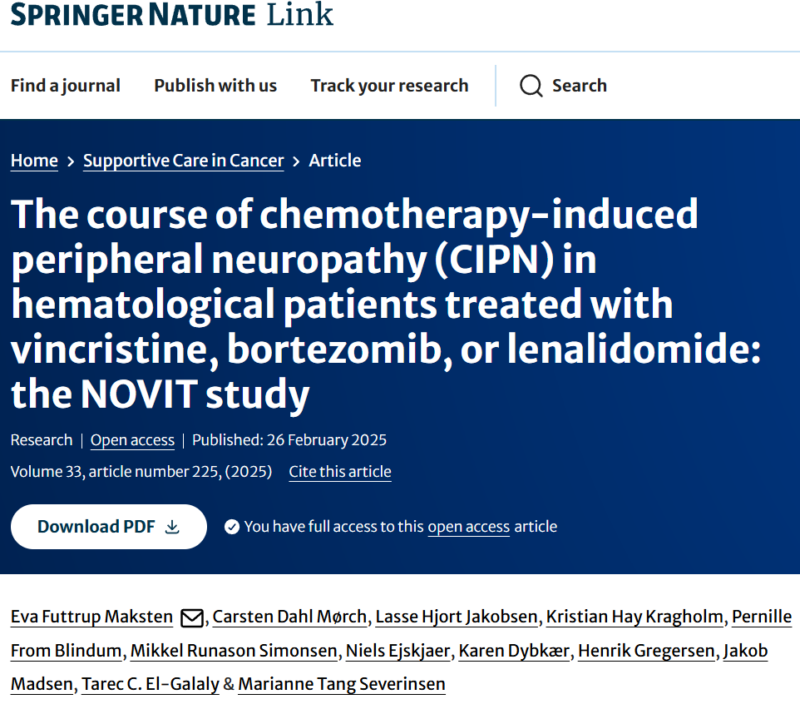Al-Ola A Abdallah, Associate Professor and Plasma Cell disorder program Director at University of Kansas Medical Center, shared a post on X:
“Chemotherapy-Induced Peripheral Neuropathy (CIPN) in Hematological Patients.
Purpose of Study:
The study aimed to assess and describe the course of CIPN in hematological patients treated with vincristine, bortezomib, or lenalidomide.
– It sought to evaluate subjective (patient-reported) and objective (clinician-assessed) methods for quantifying and grading CIPN.
– The goal to identify the time of highest CIPN risk during and after treatment and to determine the most suitable instrument for CIPN detection in a clinical setting.
– CIPN is a common side effect from treatment such as Velcade, affecting sensory, motor, and autonomic nerve fibers. The incidence varies, with reports ranging from 30-40% to as high as 85% of patients.
– A significant challenge is the lack of a “gold standard” for CIPN assessment, complicated by different chemotherapy types, pre-existing neuropathies (e.g., diabetes), and the fluctuating nature of CIPN symptoms.
– Early detection is essential, as CIPN can significantly impact daily life, causing functional disability and emotional distress.
– No great study to evaluate CIPN!!!
Methods:
– Study Design: Longitudinal observational study.
– Participants: 23 patients with lymphoma or multiple myeloma scheduled for treatment with vincristine, bortezomib, or lenalidomide.
– Exclusion Criteria: Vitamin B12 deficiency, pre-existing neural damage, severe skin disease, pacemaker. Diabetes was not an exclusion criteria.
– Treatment Regimens: 1)R-CHOP, 2)VRd, 3)VRd & HDT-ASCT 4)D-VMP.
– Assessments: CIPN was assessed at baseline (before treatment), before each chemotherapy cycle, 1 month after the last treatment, & 1 year after baseline.
Patient-Reported Outcomes:
Functional Assessment of Cancer Therapy/Gynecologic Oncology Group-Ntx-13 . A ≥ 10% decrease in the neuropathy subscale (NTX-13 score) was defined as CIPN.
– CIPN Prevalence: 47.8% of patients experienced a ≥ 10% reduction in the NTX-13 score , indicating CIPN.
Eight patients (34.8%) had treatment alterations due to neuropathy symptoms.
Only 50% of these had a ≥ 10% drop in NTX-13.
– Timing: The highest proportion of CIPN was present at cycle 3-4 and 1 month after the last treatment.
– The highest proportion of numbness & tingling in hands was seen right before cycle 3 (36.4%) and at 1 month after last treatment (57.9%) in feet. For hands and feet combined the highest proportion was seen at cycle 6 (58.3%).
No significant difference was seen in NTX-13 scores from baseline to 1 year after baseline.
There was a significant increase in QoL from baseline to 1 year after baseline.
The findings suggest that clinicians should be particularly aware of CIPN around cycles 3-4 and 1 month after treatment.
– The relatively stable NTX-13 scores could be due to pre-existing neuropathy in multiple myeloma patients.
Study Limitations:
Low number of patients,.
– No test of correlation between included tests was performed.
– Inclusion of three different types of chemotherapy with potential different profiles of CIPN.”
The course of chemotherapy-induced peripheral neuropathy (CIPN) in hematological patients treated with vincristine, bortezomib, or lenalidomide: the NOVIT study.
Authors: Eva Futtrup Maksten, et al.

